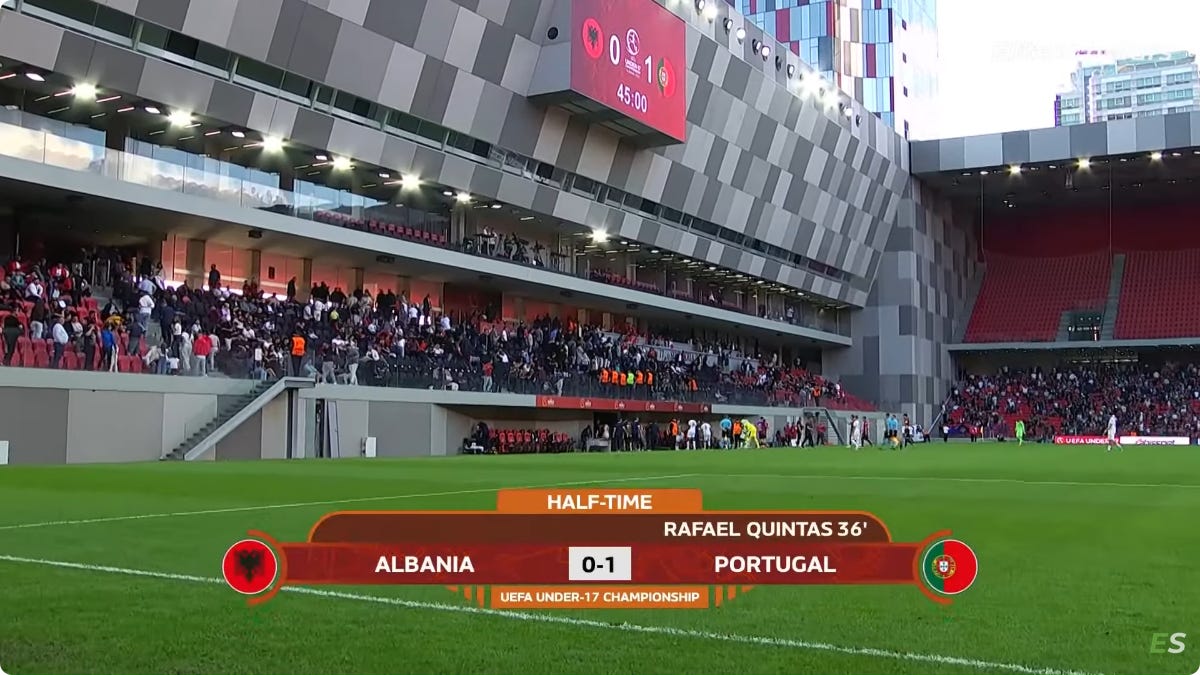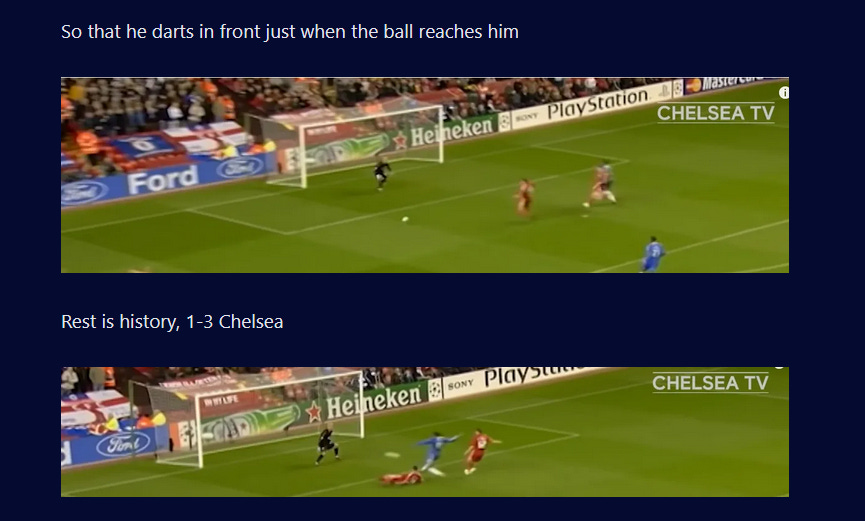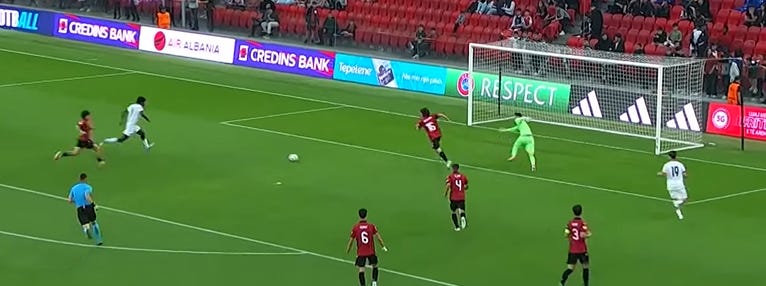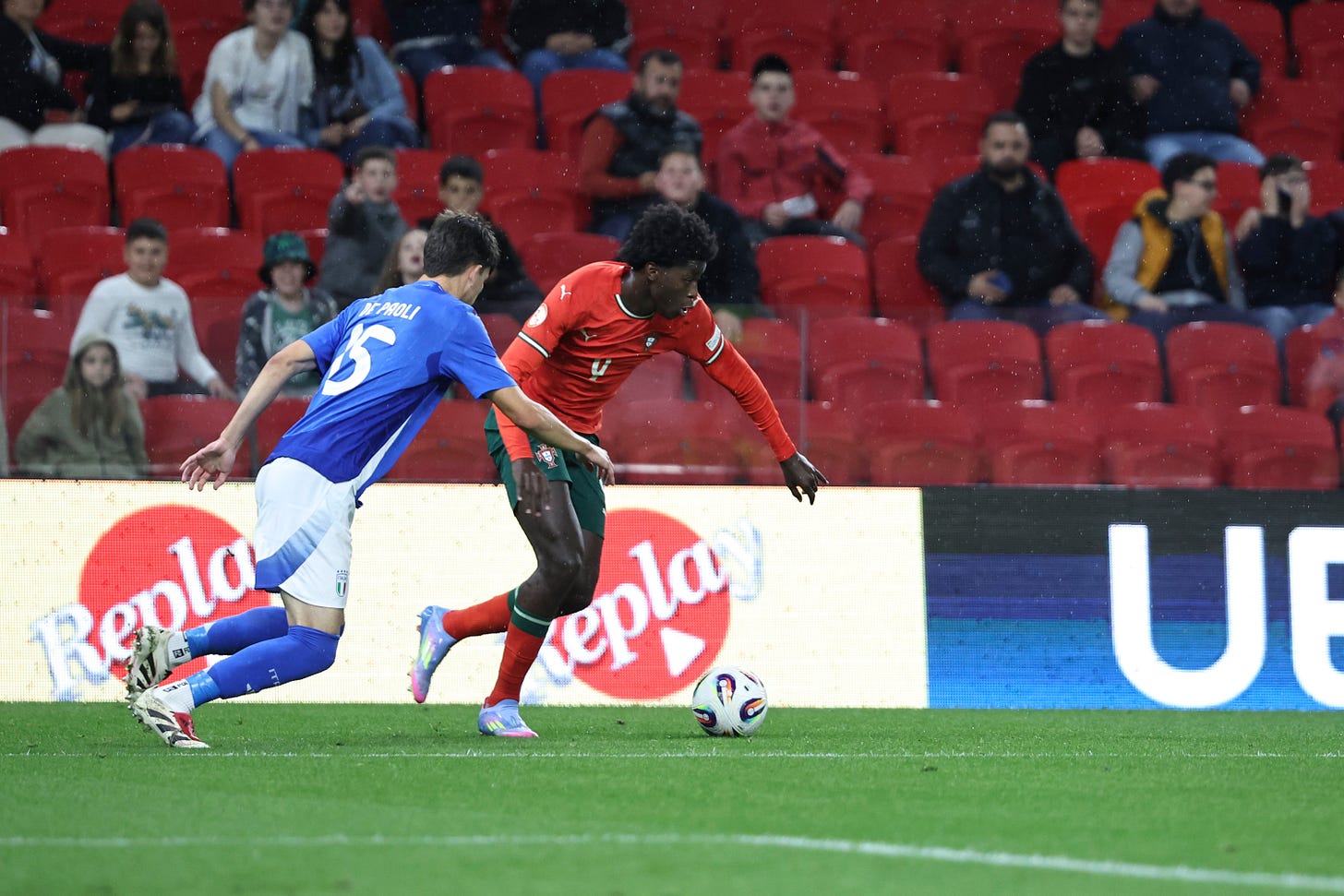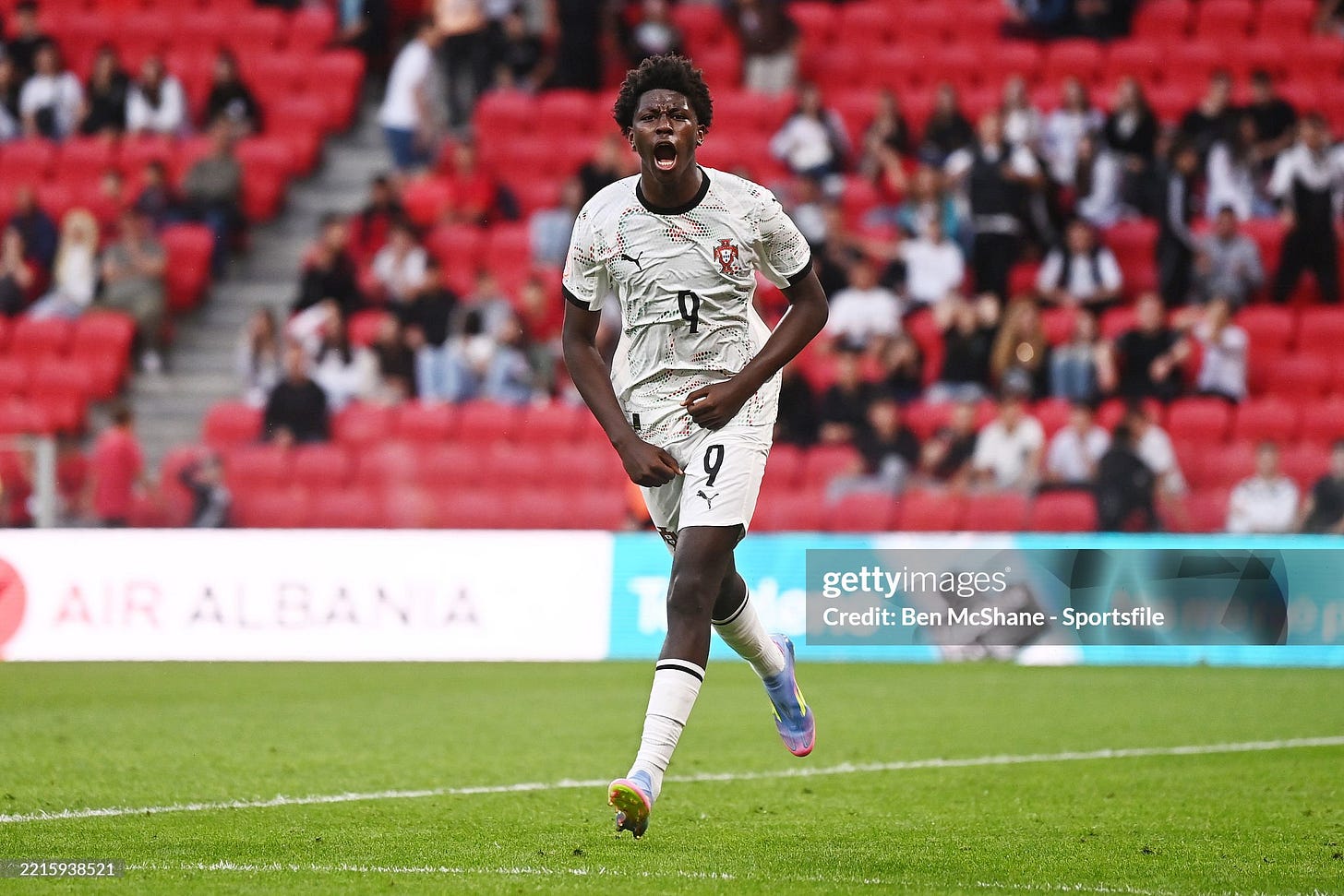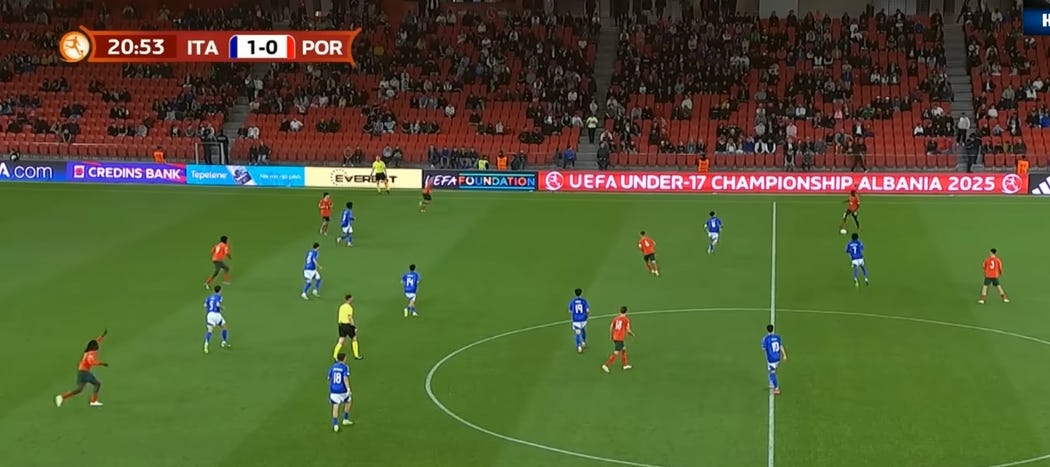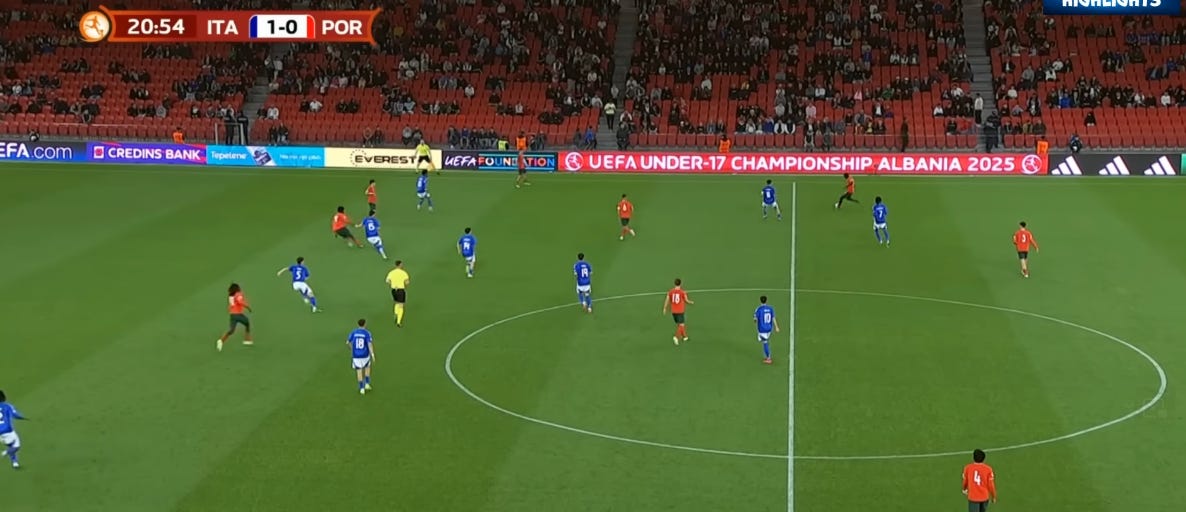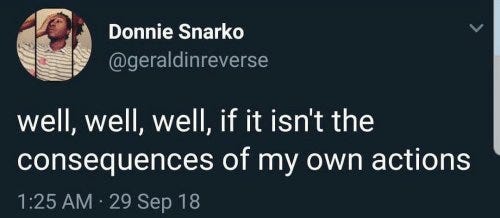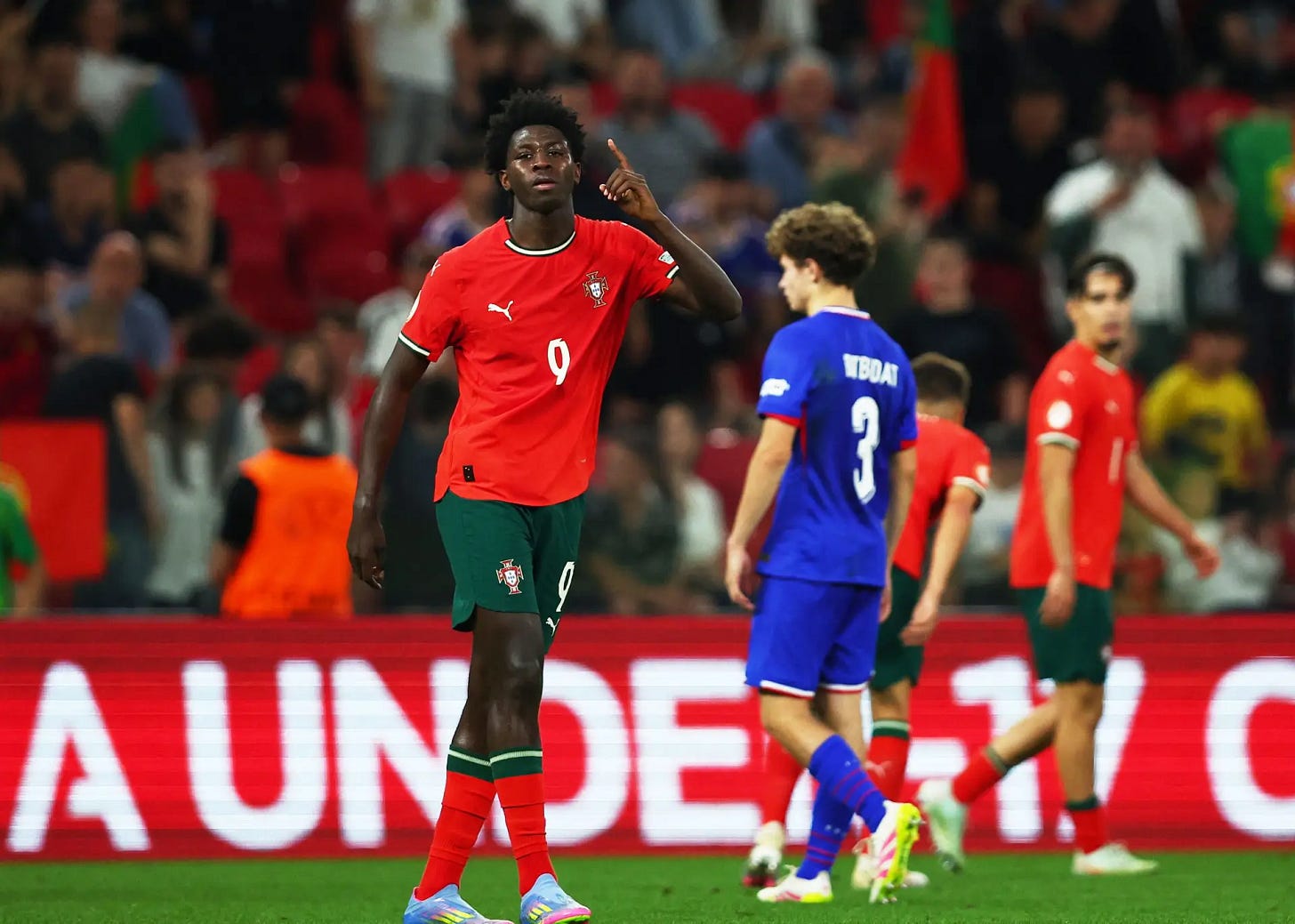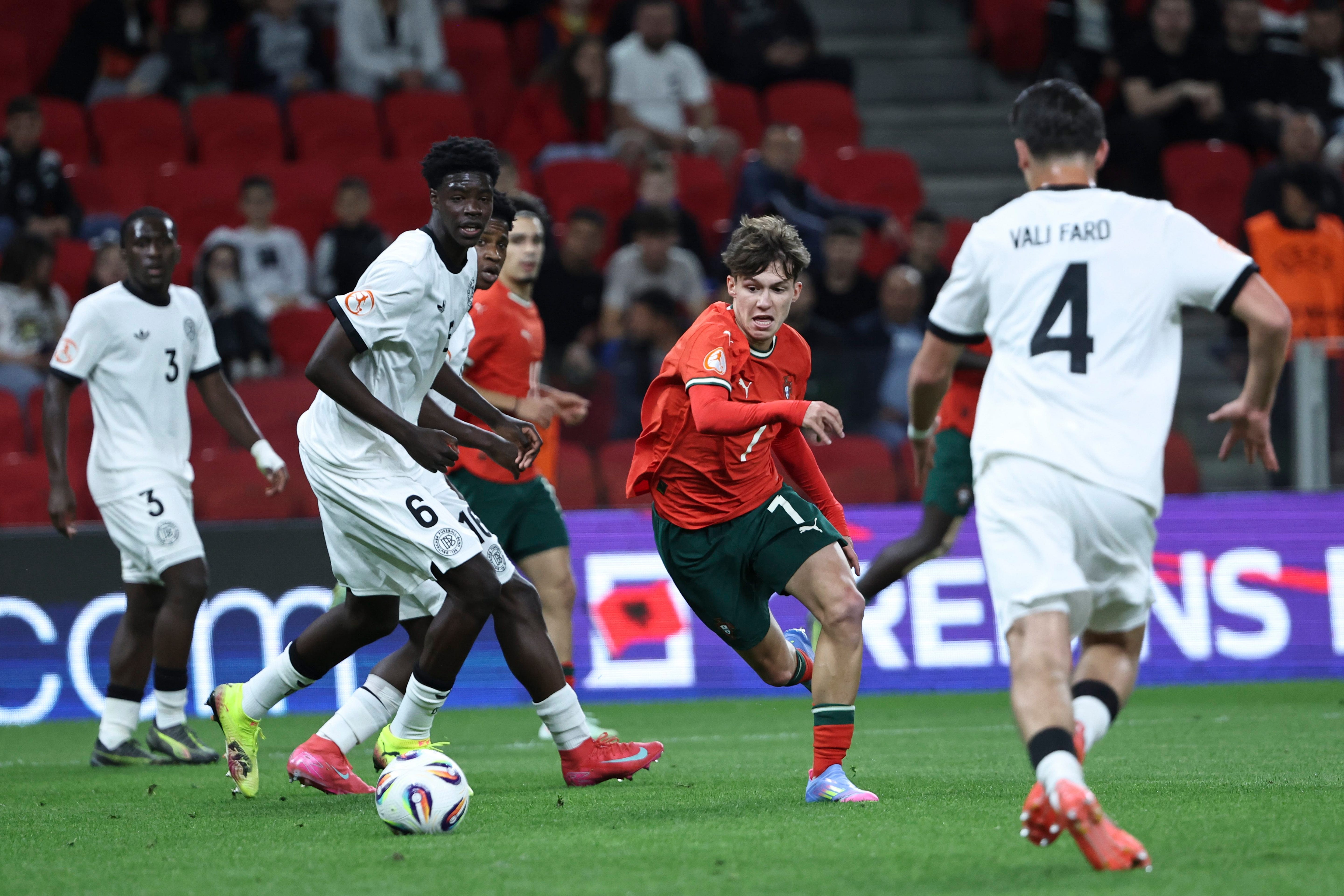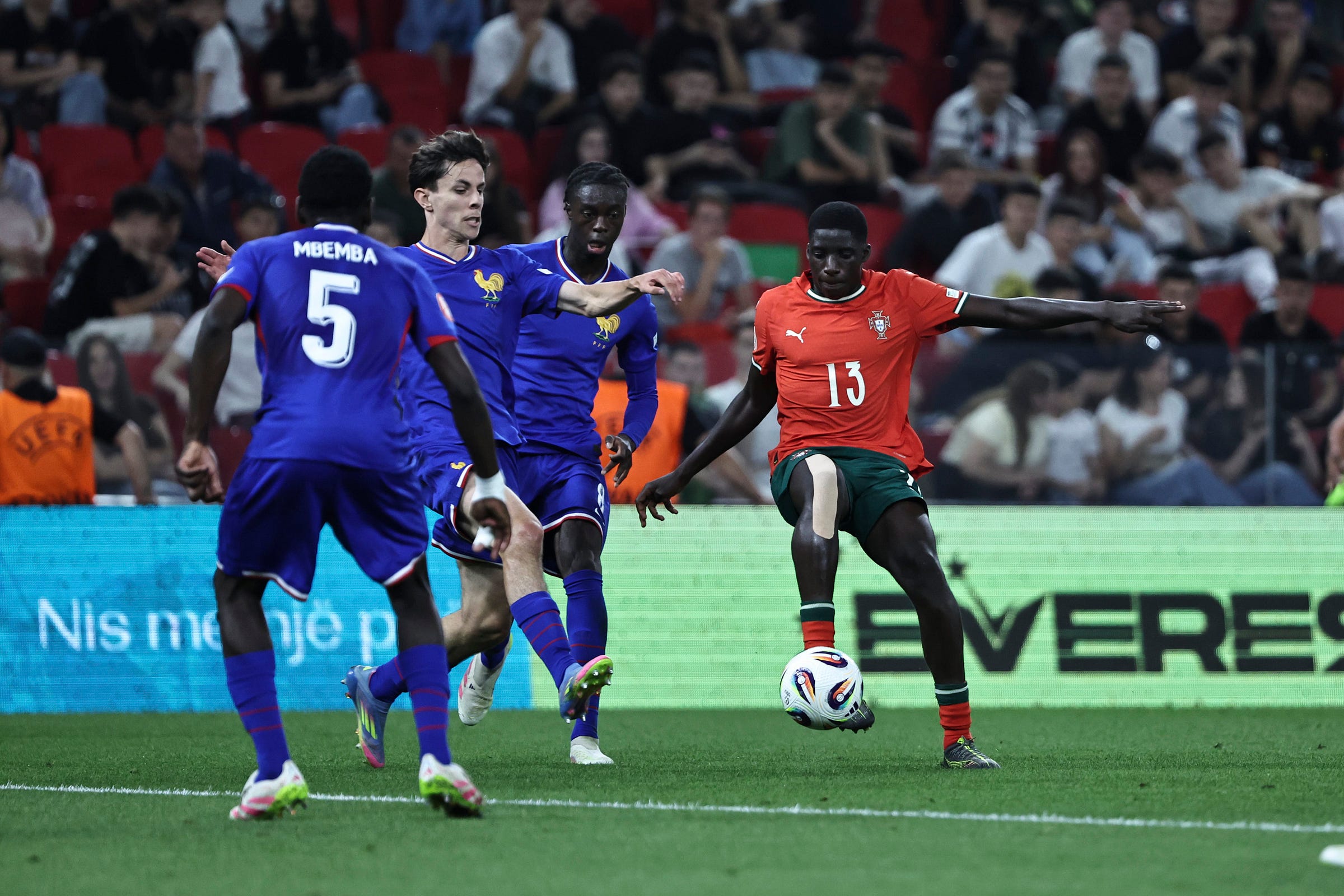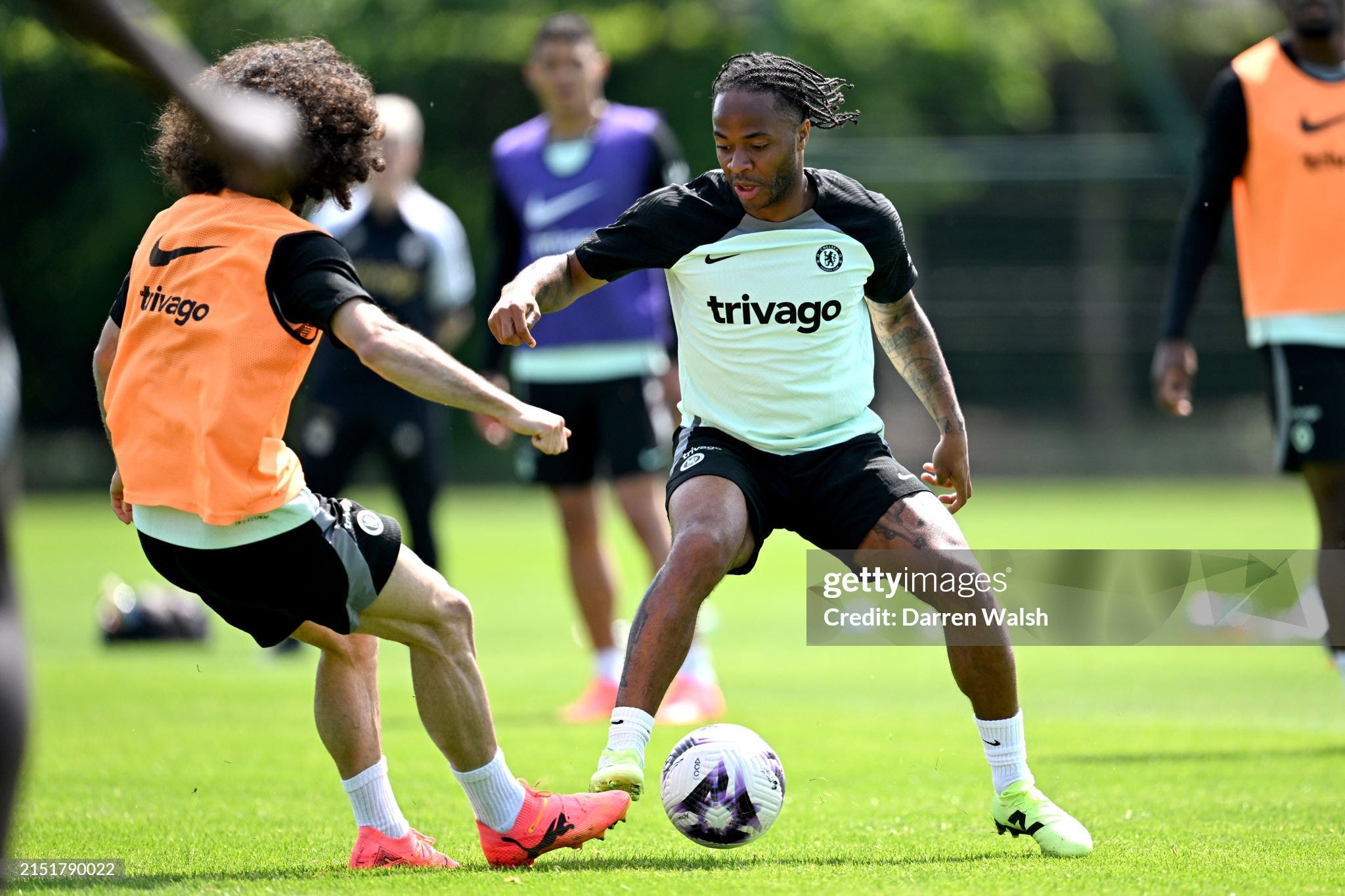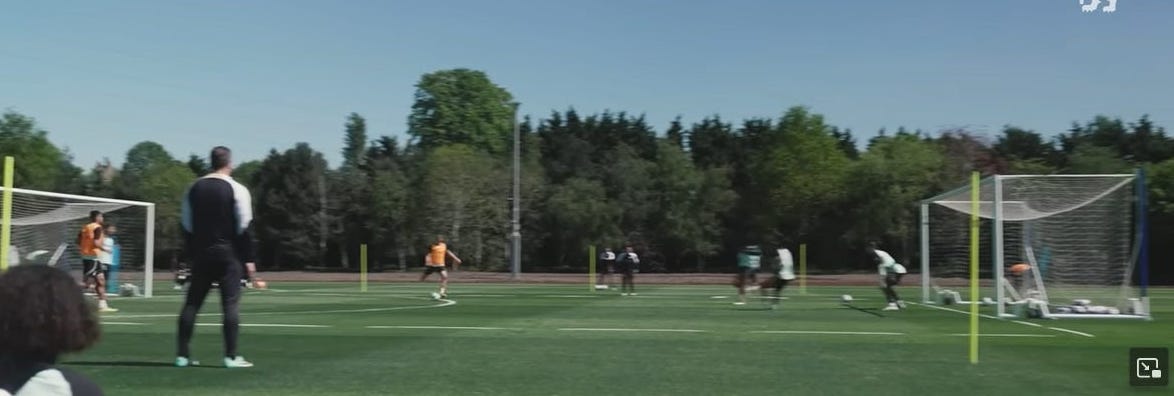The Temptations released “Cloud 9” in 1969, produced by Motown, introducing psychedelic soul to the musical landscape.
Let’s see how much that series proves to be a figment of imagination once Chelsea figure out they can’t afford to budge from the competitive wage and cycle to work scheme (to buddy up with Wesley Fofana?) package offered to Gyökeres, Šeško and Delap. To the biggest disappointment of their respective agents more than Chelsea fans in general. And once Emanuel Emegha embraces his footballing destiny to join Eddie Howe’s Newcastle.
Editor’s note: Shoud he sign for Chelsea right now? No.
A discussion about composure in the box and the movement/technical benchmarks that are usually correlated with it. Evidence-based research on skill acquisition, expertise and talent development. And how to improve “finishing skill” with two training drills
Five games ; 17 attempts, 4 on target, 2 goals.
Only thing more difficult to miss during the U17 Euros than Anísio Cabral’s goalscoring chances was Anísio Cabral himself ; spearheading Portugal’s succeess in the competition.
I saw him vs France in that drab 0-0 second group stage game. Left footed, moves about upfront and gets chances. Ok, we’ll have a look :
I was trying to think of the other Benfica striker I saw, Luis Hemir Semedo, now on Sunderland books, who caught the eye vs Bayern in the Youth League a few years ago, not just by scoring an ass goal but also running the channels and getting in the box via carries in a 0-2 win.



France won 11v10 vs Germany 3-0 ; whilst Portugal beat Albania 4-0, a scoreline that flatters the Portuguese team who only created separation twenty minutes from time to materialise their open play domination.


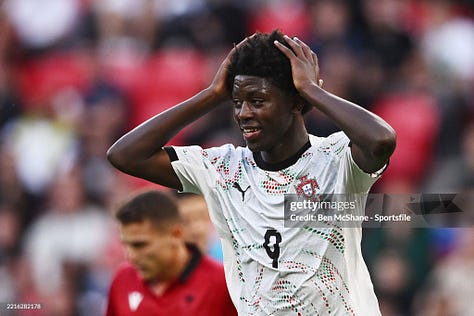
France and Portugal negated each other in a 0-0
Portugal beat Germany 2-1 with two late goals in their third Group Stage game.
France beat Belgium 3-2 whilst Portugal overcame Italy on a penalty shootout (2-2).
France and Portugal met again in the final, in which Anísio Cabral opened the scoring as his team never looked back to win 3-0.
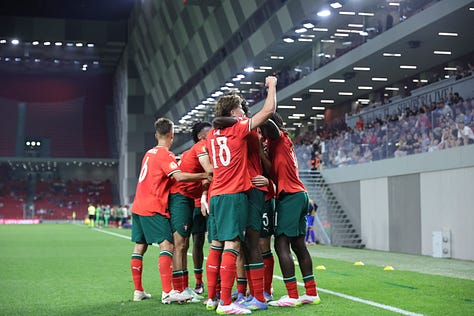

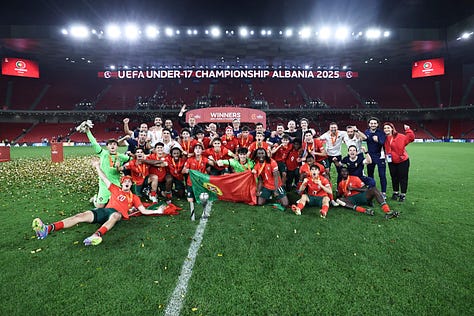
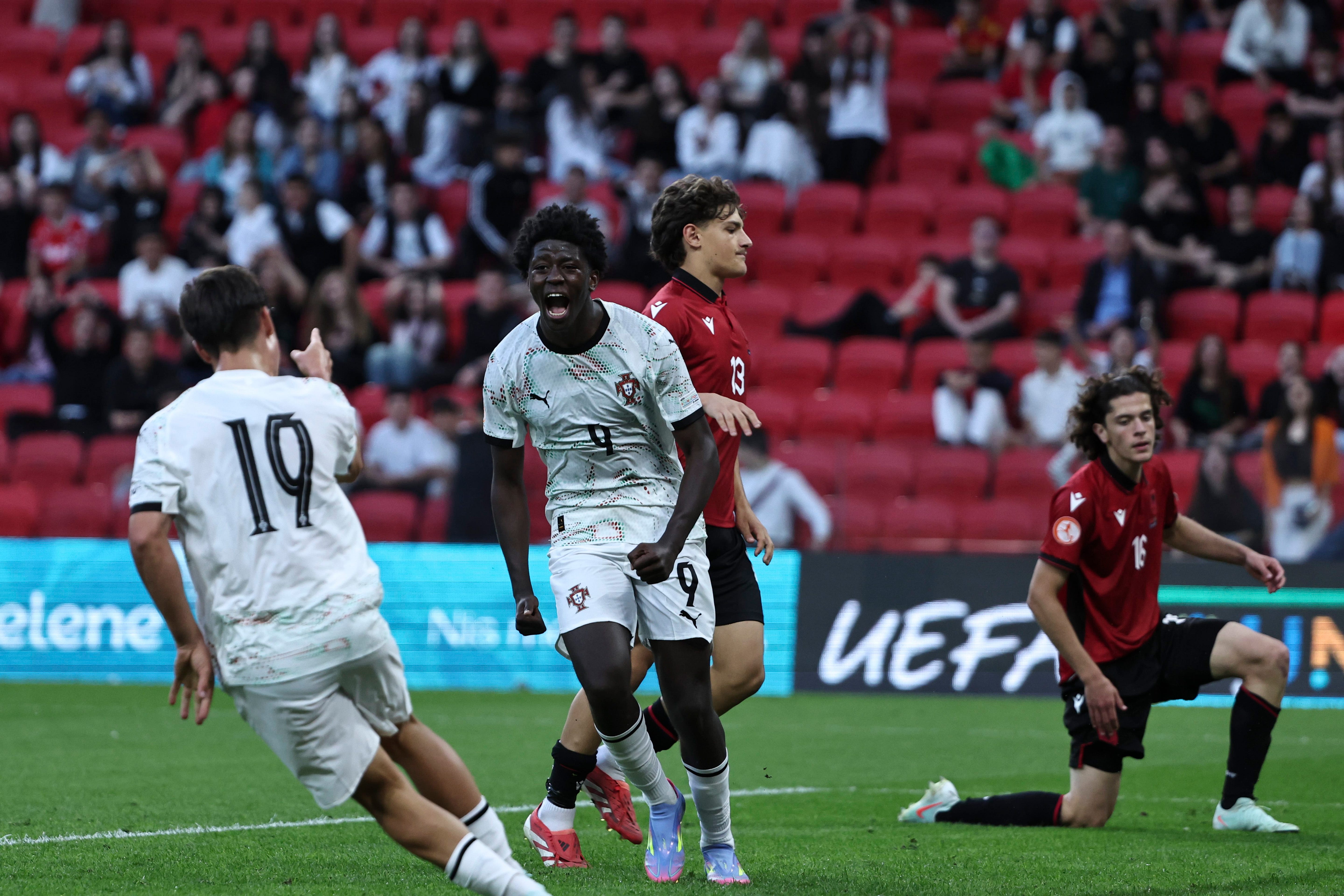
Anísio Cláudio Fernandes Reis Cabral, under contract at SL Benfica
A technical breakown of most of his chances available on film
25: reaction volley off a scrap
Still visible from the CB, at arms reach. Being blindside would help
Cross in the air, he’s flat footed ; ideally strikers need to play The Floor is Lava but not in terms of never getting in it, but by skipping as long as they’re in the box
First touch is a bit reactive but effective
Lashing out of the volley with visible fast backlift, blocked but at least gets a shot off
41 : box movement : the other way round!
Grappling with the CB is alright, but has to go around the penalty spot opposite side!
Not on the crossers’ side, consequence being that he’s visible by the defender
The decision to half volleu with the goal on his left is a reaction, would be easier to go through the ball with a better angle of approach (round the penalty spot from the other side)
57 : slow and shorter steps!
A nice pass round the corner, the mechanics are a bit awkward but it takes some strength to pull it out (a cute through pass will be easily intercepted)
Follows up on the cutback, and what the hell is this. Giant steps, like Gullivers’ Travel giants
The priority is to nail the support foot next to the ball
It either requires accurate footwork, or decelearting to maximise the possibility to do so. Some players don’t need it, but it would be advised if you can’t hit a shot on target
Consequently, support foot in a different post code
Trying to curl it, why not, but going through with the laces would be more appropriate
Shooting leg stiff to make up for the distance with the support leg
59 : Dart when the cross is hit
AC starts from opposite side of the defender, which is ok.
However triggers his run too early
Consequence, appears too early before the cross is hit
Changes direction towards his left shoulder to delay his motion (with a longer path, to keep moving)
He should be bombing to intercept the pass, but is still kickstarting from the slight change of direction he was doing
Solution to the problem is an adaptation, that hasn’t been tested (and foolproofed enough). Ideally that’s a
More appropriate to time the run so that you send the ball through where it comes from:
From this : on all rounder strikers, shooting mechanics and box movement
David Datro Fofana vs Panama 🐘 🇵🇦
David Datro Fofana has been captaining his Ivory Coast team in the opening game of the Tournoi de Toulon 2023 against Panama.
78: Through a forest of legs
Surprising to see AC not always near post, on corners or crosses
Same theme: be on toes dynamic, should be skipping where he is
As a result, the first touch is okay but the support leg in a different postcode
It’s the skipping to re-adjust that gives time to the defenders to squeeze in and block the shot
81: tap in
Anisio Cabral finally scored his team’s 3rd goal ten minutes from time
Some more gigantic steps before shooting - which he wouldn’t have to do if his run started a bit sooner
Good solution to bend it around the defender, with a quick release and short backlift
Not exactly sure what happens on the first goal in the final.
AC’s positioning isn’t good, he’s way beyond the width of the posts
I don’t really know why the DM Camara got sucked in that deep in the box, and Mbemba stepped in with a player in his back.
A two attempts effort, with the second one clipped over the goalkeeper for the opener
46th: Roof it
A run in behind, which is valuable considering the vast majority of strikers nowadays don’t run beyond
Keen to take on defenders, the nightmare combination CB hate
AC manipulates and bamboozles the defender into getting flat footed with his shoulder (parallel to the side of the box)
so that he can “banana drag” his way through the spot
Ends up byline, that he probably has to get on target, as it’s more difficult to miss the target than not. Probably tries to aim for the far corner, as opposed to the near post.
20 : Use the assistant referee
One foolproof way to beat the offside trap is to use the assistant referee
That’s a good curvilinear run
Touch on the go is good
Modern strikers who receive after a run than take on :
The decision to clip something of a cross / shot however isn’t effective
Volley in the box on a corner, again, surprising to see AC outside the box. Maybe he’s not good in the air.
Flat footed, not on toes dynamic
Therefore reacting / rushing to set his support leg
Slipping as a result
Ecological dynamics framework
Football is a complex system
A dynamical system is defined by Keith Davids as “composed of many interacting parts, and are constantly required to change the state of organisation between components” (Davids K. L., 2000)
Gréhaigne argues that football must be seen as a complex system where the variables “represent fluctuating conditions, which momentarily constrain the organisation of actions for players” (Grehaigne JF, 1997).
These actions are taken through a conjunction of “perceptual information provided by the current game context” and “knowledge-based information athletes have” like acknowledged by Steiner (Steiner S, 2018).
Correia sees ecological dynamics as providing a framework that can “unify performance analysis, skill performance and sport expertise” (Correia, 2013) in order to move on from the emphasis on “discrete cataloguing of actions”.
Professor Keith Davids from Sheffield Hallam University is one of the most renowned experts in skill acquisition, expertise and talent development in sport.


Guess who delivered a series of talks in Skill Acquisition during my MSc Football Science when my Rouen Normandie University organised a “Winter School” in partnership with Sheffield Hallam University in November 2018.
That’s right. Keith Davids.


I was just fresh from graduating with my UEFA A license at the end of 2017-18 (left) and moved up to Academy Football as U17 Assistant for QRM in 2018-19 in Normandy where we played vs PSG, Le Havre, Lens and Lille’s Academies.
Whilst undergoing my second MSc Football Training and Match Analysis year.
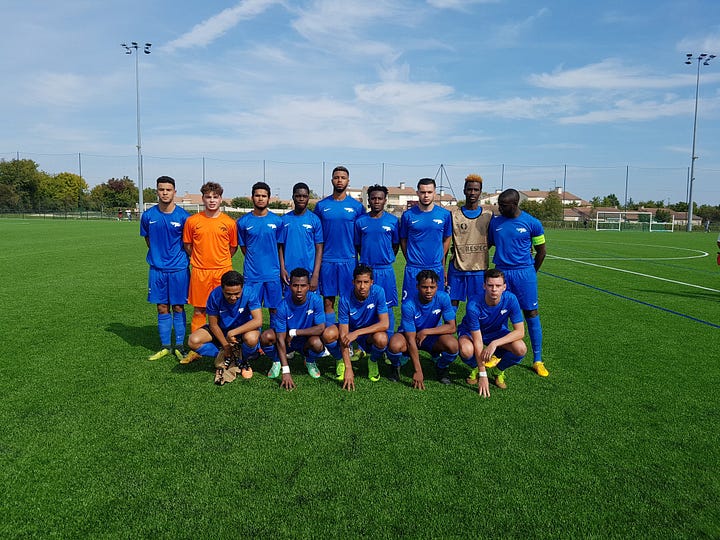
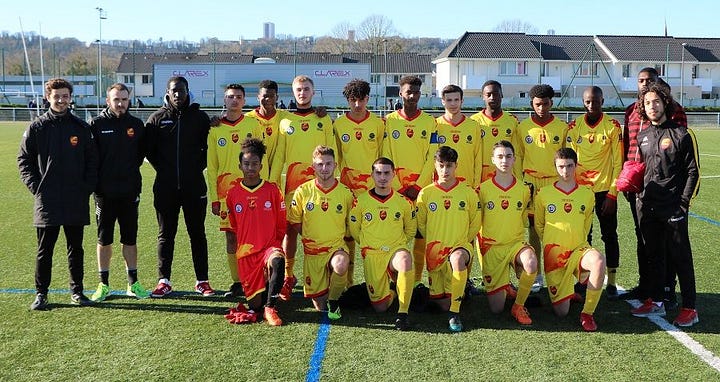
I was happy to see even more scientifically backed evidence of how to design training practices : some of it mentioned here from my UEFA A thesis
Every coaching course in the world nowadays, relies on academic publications therefore the same framework (and not twitter tacticos talking about “half spaces”, “long legs”, “juego de possebon” and “positionism vs relationism”).
Defender v attacker dyad and defensive pressure
Correia says that relying on a framework of ecological dynamics provides “a formal and theoretically grounded description of player-environment interactions” (Correia, 2013). That being in order to investigate the link between “information source” and “actions”.
The dyad between the defender and attacker is influenced by the position of the goal, with the defender trying “maintain a line between the goal and attacker”. The relative distance to the ball suggests that both are trying to coordinate their movement, but the proximity of the goal “creates a higher level of constraint on attackers”. (Davids, Travassos, & Araujo, 2010)
The challenge is therefore not so much to draw conclusions from the gaze that doesn’t indicate “using the environmental property as source of information”, but more how “perceiving action possibilities for oneself, as well as for team mates and opponents” is “ a key feature of skilled performances in team sports” (Fajen, Riley, & MT, 2009)
The notion of defensive pressure has been studied by Herold suggesting “a slight increase in pressure from the start to the end of the off-ball actions as defenders re-established proximity to the attacker after separation was created” but also that “situations with greater starting pressure on the attacker often led to greater subsequent decreases” (Herold M, 2022). Quantifying pressure is a challenge, to transform positional and tracking data into tactical insights but Andrienko et al created a “time mask” tool to analyse game episodes, on the basis of analysing the vector of the ball carrier and his opportunities to move or move the ball towards goal. (Andrienko, et al., 2017)
The ability to find separation has been investigated by Duarte who concluded that attacking players must “exploit the space-time synchrony with defenders in an unpredictable and creative way” whilst defenders “should be encouraged to adopt postures and behaviours that actively constraint attacker’s actions” in 1v1 situations. (Duarte, et al., 2012)
But biomechanics occur in an environment where players are meant to pick relevant information, through the perception-action couple. Peker (2023) looked at the “kickable gap” and concluded that gaps are perceived larger when confederates are “opponents and not team mates”, and that their defensive postures also exert influences: the gap appears to be larger when the defender is facing the gap as opposed to showing his back.
This aligns with the empirical idea, based on a defensive posture with affordances appearing in spaces where a close forward can shot through, close to the defenders’ body. On the other hand, defenders’ defensive “blocking” stance seem to oppose the direct trajectory on the floor (trailing leg), at hip level and head level (with the upper body and shoulder).
TL;DR
Must use “ecological framework” that accounts for player-environment interaction, to investigate “information and action”
Defender v Attacker is a dyad : defender gets goalside, and proximity to goal creates a bigger constraint
Defenders generally increase the pressure and shorten the distance to the attacker, but in case they start from close we imagine the forward can create separation
“Checking shoulder” (gaze) is a tool for to help perception/action possibilities
is key to grasp (for good) that there’s no attacking play without a defender to bamboozle, and no defending without an attacker to read
Jin (2013) showed, counter-intuitively that there’s a positive relationship between estimate of goal size and shooter’s position, as the carrier estimates the goal to be bigger than it is as opposed to the shooter with a stationary ball.
These findings appear fundamental to enhance the understanding of goalscoring chances, and affordances players perceive.
A strongly analytical perspective on goalscoring chances (then translated into instructions to implement in training and games) rely on finding “good locations” for their proximity to the target,
Farvardin showed that cognitive load affects kicking mechanics (knee and hip movement) depending when they had to kick a stationary ball, or follow up a pass being played to them. (Favardin, 2022)
The literature doesn’t appear to cover extensively the dyad between shooter and defender, as well as the processing of information from the environment and it’s impact on shooting mechanics. As shown previously, the defensive behaviour influences the speed of triggering a shot.
There will be two ways to improve finishing skill.
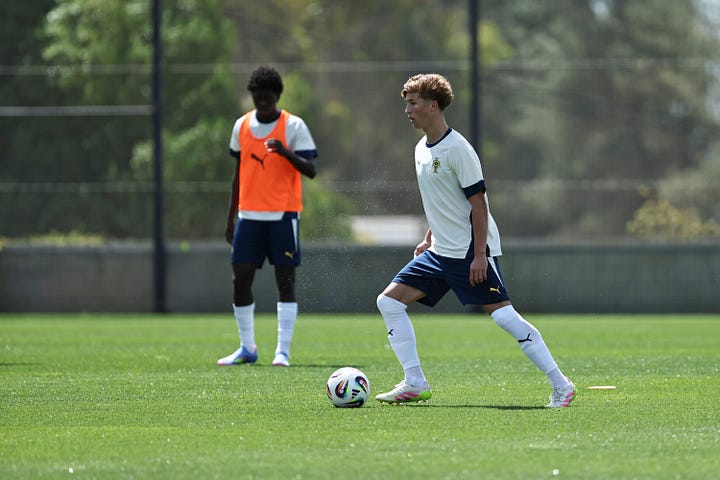
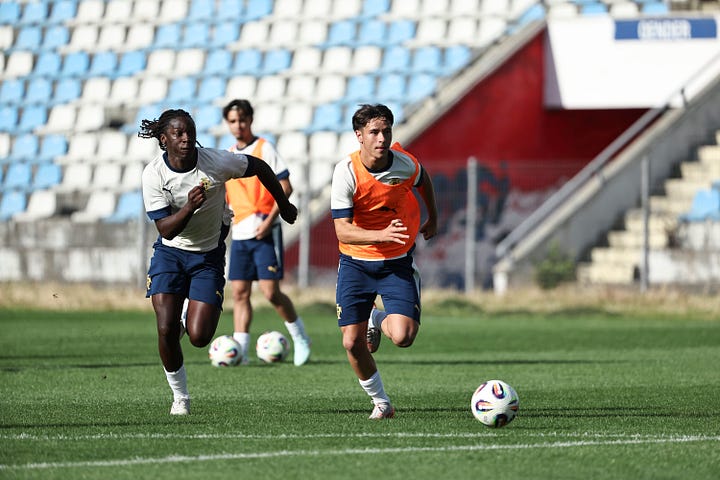
Shooting at goal isn't finishing, that's merely what the description suggests.
Finishing skill exists in the context of time and space pressure :
Training drills exist on a control to chaos continuum.
The more control on proceedings, the less chaos.
The less control… the more chaos
The art of training is to find the drill that gets the desired stimulus and occurence of the problem to solve ; whilst being rich enough for players to explore a defined range of situations (if 5 minutes get 15 unique actions, 5 more minutes will create 15 more)
You can hammer a nail 1, 10 or 100 times ; where’s the learning curve.
Give a man a nail ; plus a croissant, a rock, a pangolin and a newspaper. Go on
Explore, find a solution.
The Mac&Cheese of finishing skill:2v2
Coaches like it, players like it, tacticos hate it. What’s not to like?
“we want a teacher to teach football” - hold Cole Palmer not scoring for 6 months.
This one get you an element of control as to the boundaries, the proceedings but little as what will happen within it which will be pure chaos.
2v2 will involve squatting, pump fakes, defensive footwork. Shot vs block shots, exploit windows to shoot and no slacking because you need your team mate to create the decoy.
Refer to the above :
Peker (2023) looked at the “kickable gap” and concluded that gaps are perceived larger when confederates are “opponents and not team mates”, and that their defensive postures also exert influences: the gap appears to be larger when the defender is facing the gap as opposed to showing his back.
Raheem Sterling can finish whithin a gap he perceives, including (Colwill?) in a blocking stance (turning his back to the gap) which is harder for Sterling (as a result of being perceived as smaller).
Lots of rebounds to follow up.
There’s endless variations, more and less manufactured. Go around a pole on a touchline if you miss a shot to create a powerplay (2v1) for a little span of time that the opponent has to exploit.
Train the way you want to play
Offside is necessary in football training, but sometimes the small size of the pitch suggest you can take liberties. I’m never a big fan of no offside ; because football only ever occurs when there’s an offside line, otherwise it changes the nature of the game and the concept of defending.
Succession of tasks
Analytical drills, is it football? You’re taking away the essential part explored above.
Perception / action, and defensive pressure.
However, intense training generate demands, and you can’t obviously hammer players with strength drills (small spaces, lots of squatting jumping and shooting) that require 24-48h to recover from ; either next to a game, or close to the next game.
Isolated shooting practice is like a comfort feel good placebo, it’s effect isn’t really measured but then again it puts you in a good mood. Good confidence building “cheat code” before a game, if acknowledged as such.
Too often, too easy, or instead of working on stuff midweek ; bad like a cheeky vanilla custard of buns from home at 3pm.
A Trafalgar-like ambush and there’s 18 of those across London. Do not.
Never ; players like kicking the ball about post training. And are usually fiercely competitive. Why not merge both?
I like the idea of the succession of tasks
Some players genuinely dwell on missed chances
Some players nowadays genuinely ruin direct follow-up opportunities with their FIFA antics throwing arms, or face in hands gimmick. This is tragic that their role models are nowadays Garnacho, Felix or Hojlund, none of whom belong.
So the idea is to get players in some kind of second nature by disrupting that “dwelling” moment with an immediate follow up task.
You might get players who are brilliant at 2v2, requiring a GPS or a Tube Map to succeed at this. And the other way round. A balance of both (priorizing players who thrive in chaos 2v2, though) can create a nice alternance to break routine.
There’s three successive passes to convert into goals with a timing that
Box movement on crosses
This is one is gold and involves a standard up-back-through combination play to launch a wide player who crosses… for the opposite striker.
Striker must go around the penalty spot opposite (or don’t, and be called a donkey)
And dart to the ball when the cross is hit.
The underlying point is to “teleport” the striker into a different situation, so that he has to process the relevant cues faster. Where am I situationally with reference to both posts, and the penalty spot (using the peripheral vision), and can i quickly turn the head and train my gaze (👀) to look for the crosser and the ball.
Separation movement for the CM who has to clear the passing lane with a decoy run so that he goes towards the ball when passing forward (or don’t and clip the ball out of bounds).
References
Andrienko, G., Andrienko, N., Budziak, G., Dykes, J., Fuchs, G., von Landesberger, T., & Weber, H. (2017). Visual analysis of pressure in football. Data mining and knowledge discovery, 31(6), 1793-1839.
Correia, V. (2013). From recording discrete actions to studying continuous goal-directed behaviours in team sports. Journal of Sport Science, 31(5), 546-553.
Davids, K. L. (2000). Understanding and measuring coordination and control in kicking skills in soccer: Implications for talent identification and skill acquisition. Journal of Sport Science, 18(9), 703-714.
Davids, K. V., Travassos, B., & Araujo, D. (2010). Ball and goal location as constraints on decision making in team sports. Journal of Science and Medecine in Sport, 13.
Duarte, R., Araujo, D., David, K., Travassos, B., Gazimba, V., & Sampaio, J. (2012). Interpersonal coordination tendencies shape 1-vs-1 sub-phase performance outcomes in youth soccer. Journal of Sports Science, 30(9), 871-877
Fajen, B., Riley, M., & MT, T. (2009). Information, affordances, and the control of action in sport. International Journal of Sport Psychology, 40, 79-107.
Farvardin F, A. T. (2022). The Effects of Increasing Cognitive Load on Support Limb Kicking Mechanics in Male Futsal Players. Journal of motor behavior, 54(4), 438-446.
Grehaigne JF, B. D. (1997). Dynamic system analysis of opponent relationships in collective action in Soccer. Journal of Sport Science, 15, 137-149.
Jin Z, L. Y. (2013). Enlargement of perceived target size: intentional or natural? Perceptual and motor skills, 117(3), 855-67.
Peker AT, B. V. (2023). Perception of higher-order affordances for kicking in soccer. Journal of experimental psychology. Human perception and performance, 49(5), 623-634.
Steiner S. (2018). Passing Decisions in Football: Introducing an Empirical Approach to Estimating the Effects of Perceptual Information and Associative Knowledge. Frontiers in Psychology, 9.
Training drills are from my own training sessions.














